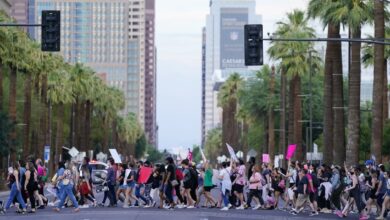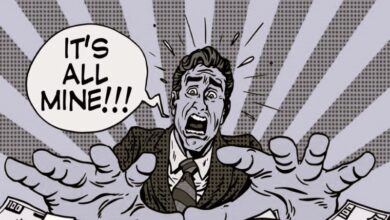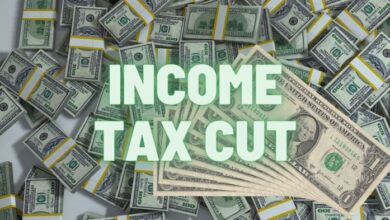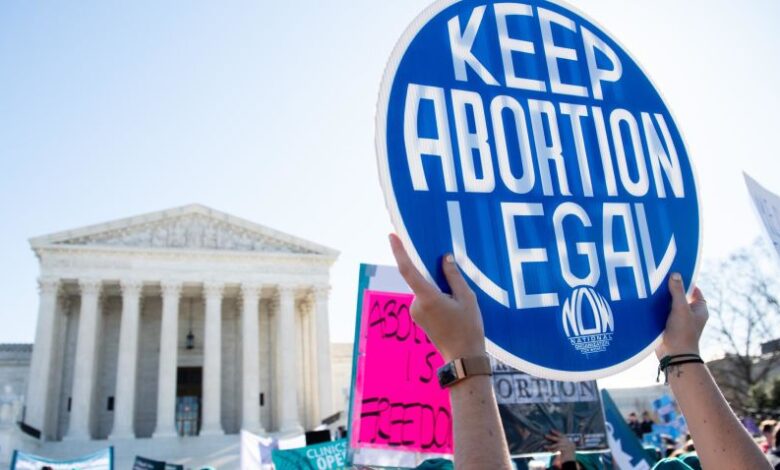
Abortion Ruling: A Political Earthquake
The abortion ruling is set to be a political earthquake, shaking the foundations of American society and igniting a firestorm of debate. This landmark decision, overturning decades of precedent, has sent shockwaves across the nation, sparking protests, legal challenges, and a renewed focus on women’s rights.
It’s a watershed moment, one that will have far-reaching consequences for generations to come.
The ruling has ignited a fierce debate, dividing the country along ideological lines. Supporters of the decision celebrate the restoration of states’ rights and the protection of unborn life. Opponents argue that it represents a grave setback for women’s reproductive rights, potentially leading to a resurgence of unsafe abortions and further marginalizing vulnerable populations.
The Historical Context
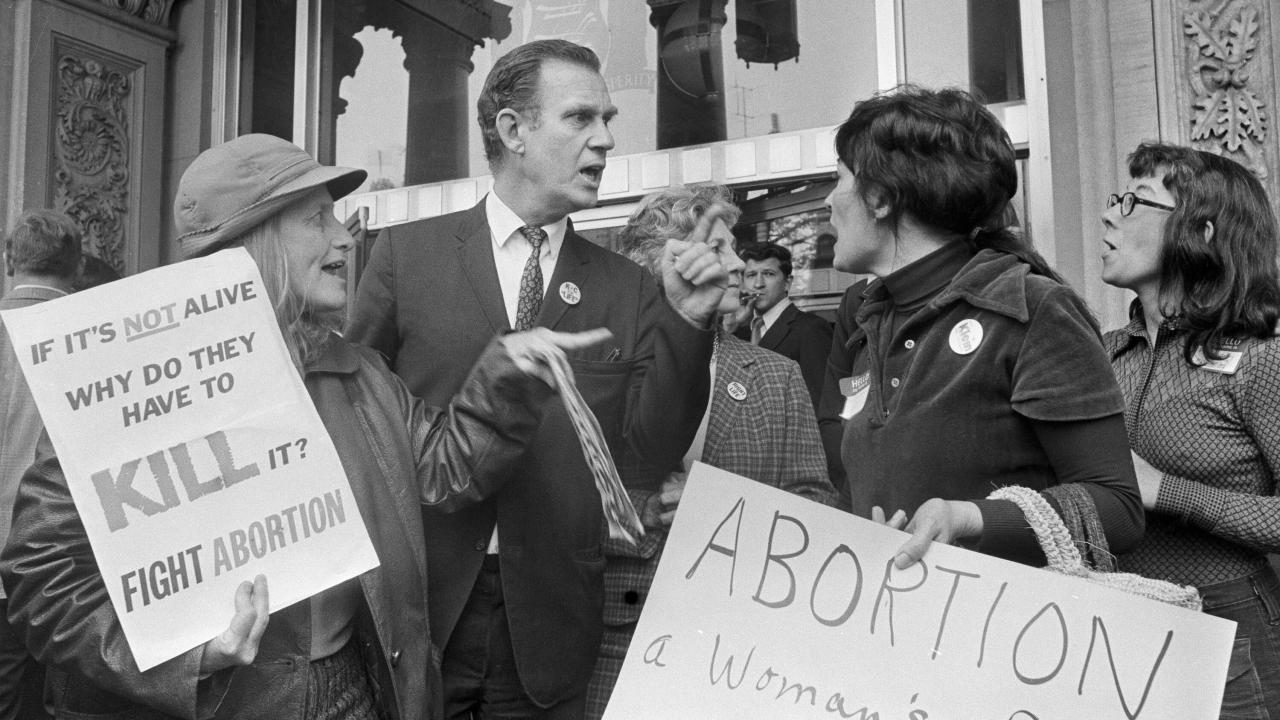
The overturning of Roe v. Wade by the Supreme Court in 2022 was a landmark decision that has had a profound impact on the legal and social landscape surrounding abortion in the United States. This decision, which effectively returned the issue of abortion to individual states, was the culmination of decades of legal and political battles that have shaped the national debate on abortion.
To understand the full significance of this ruling, it’s essential to examine the historical context that led to it.
The Legal Landscape Before Roe v. Wade
Prior to Roe v. Wade, the legal landscape surrounding abortion in the United States was largely defined by state laws. These laws varied significantly from state to state, with some states having relatively liberal abortion laws and others having very restrictive laws.
Many states prohibited abortion except to save the life of the mother. The legality of abortion was often contested, with numerous legal challenges to state abortion laws being filed in courts across the country.
Key Events and Supreme Court Decisions Leading to Roe v. Wade
The landmark Roe v. Wade decision was not a sudden or unexpected development. It was the culmination of a series of events and Supreme Court decisions that gradually shifted the legal landscape surrounding abortion.
- Griswold v. Connecticut (1965): This decision established a right to privacy for married couples to use contraceptives, setting a precedent for recognizing a right to privacy in personal decisions.
- Eisenstadt v. Baird (1972): This decision extended the right to privacy to unmarried individuals, making contraception legal for all adults.
- Roe v. Wade (1973): This landmark decision recognized a woman’s right to an abortion under the right to privacy established in the Fourteenth Amendment. The Court ruled that states could not ban abortion in the first trimester of pregnancy and could only regulate abortion in the second and third trimesters to protect the health of the mother.
The abortion ruling is set to be a political earthquake, with far-reaching implications for women’s rights and the future of the Supreme Court. In the midst of this upheaval, it’s also worth considering how businesses are adapting to the changing landscape of work.
A recent article on council post three ways to transform your commercial office space in response to remote work offers insights into how companies can create more flexible and attractive work environments, which could become even more critical in the wake of this landmark ruling.
Evolving Political and Cultural Debates Following Roe v. Wade
Following Roe v. Wade, the political and cultural debates surrounding abortion intensified. Pro-choice advocates celebrated the decision as a victory for women’s rights and reproductive freedom, while pro-life advocates condemned the decision as a moral travesty. The debate was further fueled by the rise of the “culture wars” in the 1980s and 1990s, which saw a growing divide between conservative and liberal values.
- The “Right to Life” Movement: The “right to life” movement emerged as a strong force in the anti-abortion movement. This movement sought to overturn Roe v. Wade and ban all abortions.
- The “Pro-Choice” Movement: The “pro-choice” movement advocated for a woman’s right to choose whether or not to have an abortion.
This movement emphasized women’s autonomy and reproductive rights.
- The “Partial-Birth Abortion” Debate: The debate over “partial-birth abortion” became a highly contentious issue in the 1990s. This procedure, which involves a late-term abortion, was condemned by pro-life advocates as cruel and inhumane.
The Impact of the Ruling
The Supreme Court’s decision to overturn Roe v. Wade has had a profound and immediate impact on access to abortion in the United States, creating a patchwork of laws across the country and significantly affecting women’s health and reproductive rights.
The ruling has also ignited a national debate about the role of the government in regulating reproductive healthcare, with far-reaching implications for American society.
The abortion ruling is set to be a political earthquake, reverberating through every level of government and society. While the focus is on the legal and social implications, the economic fallout is also a major concern. Biden’s visit to the Port of Los Angeles, where he’ll address the global nature of inflation, biden to visit port of los angeles casting inflation as a global problem , underscores the interconnectedness of these issues.
The abortion ruling, with its potential to further divide the nation, could exacerbate existing economic tensions, making it even more challenging to address the inflation crisis.
Access to Abortion in Various States
The ruling has led to a dramatic shift in access to abortion services across the country. In many states, abortion has been effectively banned or severely restricted, forcing women to travel long distances to access care or resorting to unsafe methods.
- In Texas, for instance, a law banning abortion after six weeks of pregnancy has effectively shut down most abortion clinics in the state. Women seeking abortions have been forced to travel to neighboring states, such as Oklahoma and New Mexico, where access is still available, or resort to seeking abortions online or through unregulated providers.
- Similar restrictions have been enacted in other states, including Alabama, Arkansas, and Mississippi, creating a situation where access to abortion is highly variable depending on location.
The Impact on Women’s Health and Reproductive Rights
The ruling has had a direct impact on women’s health and reproductive rights, particularly for low-income women and women of color, who often face greater barriers to accessing healthcare.
- For example, in states where abortion is banned, women may be forced to carry unwanted pregnancies to term, increasing the risk of complications and maternal mortality. This is especially concerning given that the United States already has a higher maternal mortality rate than other developed countries.
The abortion ruling is set to be a political earthquake, shaking the foundations of American democracy. This is especially true considering how influential election deniers have fueled a fight to control elections, as we saw in the recent midterm elections.
Their efforts to undermine faith in our electoral system are a direct threat to the very core of our nation’s governance, and the abortion ruling will only further exacerbate these tensions.
- The ruling also threatens to exacerbate existing health disparities, as women in marginalized communities are more likely to experience economic hardship and lack access to quality healthcare.
Potential Long-Term Implications for American Society
The long-term implications of the ruling are still unfolding, but it is clear that the decision will have a profound impact on American society.
- One potential consequence is a rise in maternal mortality rates, particularly in states where abortion is banned or severely restricted. Studies have shown that access to safe and legal abortion is essential for reducing maternal mortality.
- The ruling could also lead to increased economic hardship for women, as they may be forced to stay in jobs they don’t want or take on additional financial burdens to support their families.
- Furthermore, the ruling has fueled a national debate about the role of the government in regulating reproductive healthcare, potentially leading to further restrictions on women’s rights and access to contraception.
Political Ramifications
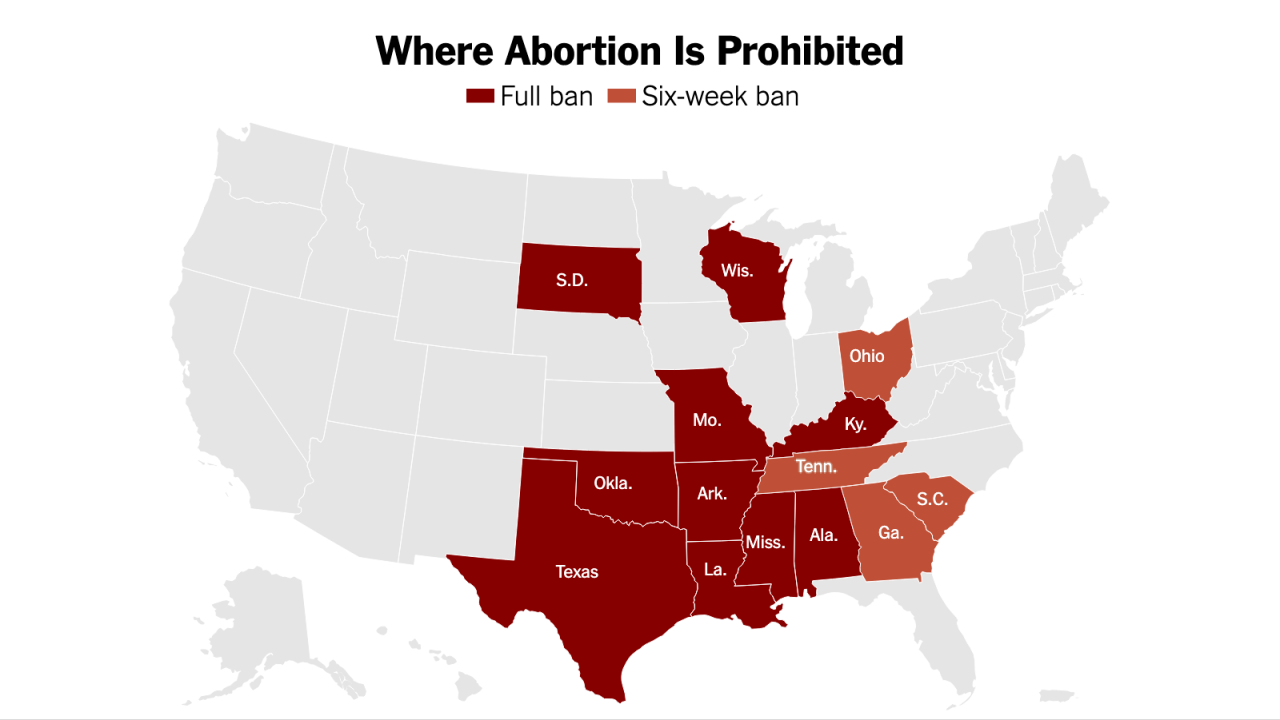
The Supreme Court’s decision to overturn Roe v. Wade has sent shockwaves through the American political landscape, with profound implications for the 2022 midterm elections and the future of abortion rights in the United States. The ruling has galvanized both sides of the issue, with the potential to drive voter turnout and reshape the political landscape for years to come.
Impact on the 2022 Midterm Elections, The abortion ruling is set to be a political earthquake
The ruling is likely to have a significant impact on the 2022 midterm elections, particularly in states where abortion access is now restricted or banned. The issue is expected to energize both Democratic and Republican voters, potentially driving higher turnout in key races.
- In states where abortion is now restricted or banned, the issue is likely to be a top priority for voters, particularly women. This could benefit Democratic candidates who support abortion rights, as they seek to mobilize voters who are concerned about the loss of reproductive healthcare access.
- Conversely, the ruling could also motivate Republican voters who oppose abortion. This could lead to increased turnout in states where abortion is now restricted or banned, potentially giving Republican candidates an advantage in races where the issue is highly salient.
Key Political Players and Their Stances
The ruling has further polarized the political landscape, highlighting the stark divide between the two major parties on the issue of abortion.
- The Democratic Party has largely supported abortion rights, with many prominent Democrats calling for the codification of Roe v. Wade into federal law. This stance is likely to resonate with many Democratic voters who are deeply concerned about the loss of reproductive healthcare access.
- The Republican Party, on the other hand, has largely supported restrictions on abortion, with many Republicans celebrating the overturning of Roe v. Wade. This stance is likely to resonate with many Republican voters who oppose abortion on moral or religious grounds.
Increased Political Polarization and Activism
The ruling has ignited a wave of political activism on both sides of the issue, with protests and demonstrations taking place across the country. This surge in activism is likely to continue in the months and years ahead, as both sides seek to influence the political debate on abortion.
- Pro-choice activists are organizing to defend abortion rights and access, while pro-life activists are celebrating the overturning of Roe v. Wade and seeking to further restrict abortion access.
- This increased political polarization and activism is likely to have a significant impact on the political landscape, shaping the debate on abortion for years to come.
Public Opinion and Social Impact: The Abortion Ruling Is Set To Be A Political Earthquake
The Supreme Court’s decision to overturn Roe v. Wade has sent shockwaves through American society, sparking intense debate and galvanizing public opinion on both sides of the abortion issue. While the ruling has been met with fierce opposition from pro-choice advocates, it has also been celebrated by anti-abortion groups who have long sought to overturn Roe.
Public Opinion Polls
Public opinion polls conducted in the wake of the ruling reveal a deeply divided nation. While a majority of Americans support some form of legal access to abortion, there is no consensus on the extent of this access.
- A Gallup poll conducted in June 2022 found that 80% of Americans believe abortion should be legal in at least some circumstances, while 19% believe it should be illegal in all circumstances.
- A Pew Research Center poll conducted in the same month found that 61% of Americans believe abortion should be legal in all or most cases, while 38% believe it should be illegal in all or most cases.
These polls highlight the complex and nuanced nature of public opinion on abortion, with a significant number of Americans holding views that fall somewhere between the two extremes.
Diverse Perspectives and Reactions
The Supreme Court’s ruling has ignited a firestorm of reactions across the United States. Pro-choice advocates have expressed outrage and fear, while anti-abortion groups have celebrated the decision as a victory for life. The ruling has also sparked a range of reactions from individuals and groups who hold more nuanced views on abortion.
- Many Americans are concerned about the impact of the ruling on women’s health and access to healthcare. They fear that the decision will disproportionately affect low-income women and women of color, who may lack the resources to travel to states where abortion is still legal.
- Others are concerned about the potential for increased criminalization of abortion, with some states already passing laws that criminalize abortion providers and even women who seek abortions.
- Still others are worried about the impact of the ruling on the broader political landscape, fearing that it will lead to further erosion of women’s rights and freedoms.
The diverse perspectives and reactions to the ruling underscore the deeply personal and complex nature of the abortion issue.
Social Movements and Activism
The Supreme Court’s ruling has reignited the abortion debate and energized social movements on both sides of the issue. Pro-choice advocates have stepped up their activism, organizing protests and demonstrations across the country. They are also working to raise awareness about the impact of the ruling on women’s health and access to healthcare.
- Anti-abortion groups, meanwhile, have celebrated the ruling as a victory and are working to pass stricter abortion bans in states across the country. They are also working to promote adoption and other alternatives to abortion.
- The ruling has also led to a surge in activism among groups that advocate for reproductive justice, which encompasses a broader range of issues related to women’s health and reproductive rights, including access to contraception, maternal healthcare, and sex education.
The Supreme Court’s decision has sparked a renewed wave of social activism that is likely to have a significant impact on the political landscape in the years to come.
Legal Challenges and Future Implications
The Supreme Court’s decision in Dobbs v. Jackson Women’s Health Organization has sparked a wave of legal challenges and raised significant questions about the future of reproductive rights in the United States. This ruling, which overturned Roe v. Wade and Planned Parenthood v.
Casey, has created a complex legal landscape where states now have the authority to regulate or ban abortion. This has led to a flurry of legal action, with both pro-choice and pro-life groups actively pursuing their respective agendas.
Potential Legal Challenges
The Dobbs decision has opened the door for a wide range of legal challenges, both at the state and federal levels.
- State-Level Challenges:Many states have already enacted or are considering enacting laws that restrict or ban abortion. These laws are likely to be challenged in court, with arguments centered on constitutional rights, medical necessity, and the undue burden standard. For example, a state law banning abortion after six weeks of pregnancy could be challenged on the grounds that it violates a woman’s right to privacy or that it imposes an undue burden on her access to abortion care.
- Federal-Level Challenges:The Biden administration has vowed to protect access to abortion care, and it is likely to take legal action to challenge state laws that restrict or ban abortion. The administration could also seek to codify Roe v. Wade into federal law, which would require congressional approval.
- Challenges to Existing Laws:The Dobbs decision could also lead to challenges to existing laws that protect access to abortion. For example, states with laws protecting abortion rights may face legal challenges from anti-abortion groups seeking to overturn those laws.
Potential for Further Legal Action
The legal landscape surrounding abortion is likely to remain highly contested in the coming years.
- Increased Restrictions:Anti-abortion groups are likely to continue pushing for further restrictions on abortion access, including bans on all abortions, even in cases of rape or incest. They may also seek to restrict access to abortion medication and to criminalize those who help women obtain abortions.
- Expansion of Access:Pro-choice groups will continue to fight for the right to abortion access and to protect existing laws that safeguard abortion rights. They may also seek to expand access to abortion care, such as by ensuring that abortion services are available in all states and by providing financial assistance to women who need to travel out of state for abortion care.
- Legal Battles over Medication Abortion:The future of medication abortion, which involves taking pills to terminate a pregnancy, is uncertain. Anti-abortion groups are seeking to restrict access to medication abortion, and legal challenges are likely to arise over the legality of these restrictions.
Long-Term Implications for Reproductive Rights
The Dobbs decision has had a profound impact on the legal landscape surrounding reproductive rights.
- Erosion of Privacy Rights:The ruling has eroded the right to privacy, which has been used to protect access to abortion and other reproductive health care services. This could have implications for other areas of law, such as contraception and same-sex marriage.
- Increased Inequality:The Dobbs decision is likely to exacerbate existing inequalities in access to reproductive health care. Women of color, low-income women, and rural women are more likely to be disproportionately affected by restrictions on abortion access.
- Challenges to Constitutional Protections:The Dobbs decision has raised questions about the strength of constitutional protections for individual rights. The ruling suggests that the Supreme Court may be willing to overturn other precedents that have been established based on the right to privacy.
Outcome Summary
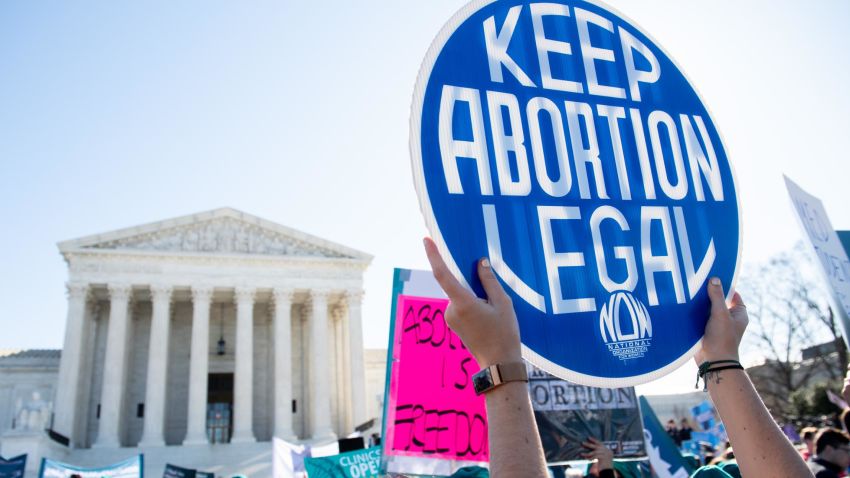
The abortion ruling is a pivotal moment in American history, one that will continue to be debated and analyzed for years to come. Its impact will be felt not only in the political arena but also in the lives of countless individuals and families.
As we navigate this complex and emotionally charged issue, it’s essential to approach the conversation with empathy, understanding, and a commitment to protecting the rights and well-being of all Americans.

